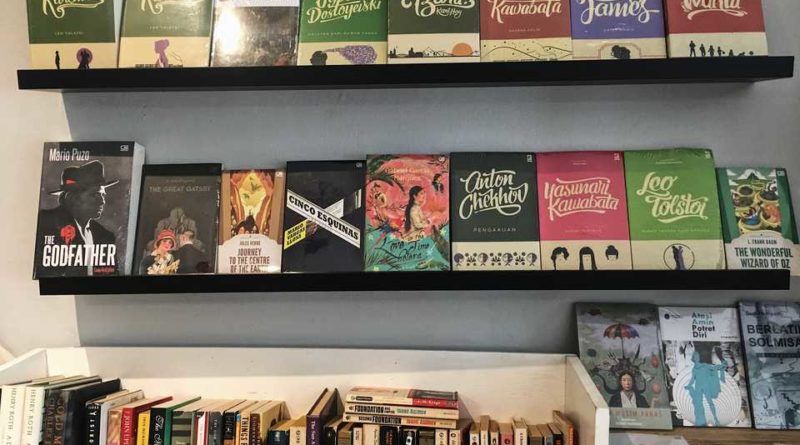LITERATURE: JAKARTA- Where Are the Serious Young Adult Novels in Indonesia?
.
Jakarta. One of the more interesting literary trends lately is Young Adult, or YA, writers addressing serious issues in a personal – okay, sometimes simple if not simplistic way – but still leaving a profound impact on their young readers.
This has been the case with global best-sellers like John Green’s “The Fault in Our Stars,” which is about two teens battling cancer. How can you get more serious than that?
Other examples include Jay Asher’s “13 Reasons Why,” which tackles the subjects of bullying, rape and suicide in a novel with a high-school setting complete with all its typical tropes – cheerleaders, football jocks, homecoming dance.
Other YA novels are more political. Nicola Yoon’s “The Sun Is Also a Star” tackles immigration and displacement, presenting a meet cute between a Korean-American high-school student with the daughter of illegal Jamaican immigrants who are about to get deported.
.
.
ADS by Cloud 9:
.
– SPACE RESERVE FOR YOUR ADVERTISEMENT –
.
.
“Simon and the Homo Sapiens Agenda” by Becky Albertalli is more lighthearted. It narrates the story of Simon, a gay student who is still afraid to come out to his family and friends. His only outlet is his correspondences with a mysterious gay student from the same school.
Despite the serious issues, these books are told in simple language, mostly from a first-person standpoint and tick all the boxes of what makes a teen book or film, including putting romance right at the forefront.
These books are veritable best-sellers in the global market and many of them have been adapted into movies and television series.
.
.
ADS by Cloud 9:
.
– SPACE RESERVE FOR YOUR ADVERTISEMENT –
.
.
Indonesian YA
Sadly, Indonesian YA writers are not as progressive.
According to Gramedia Pustaka Utama YA editor Novera Kresnawati, most YA books published by the publishing company – the largest in Indonesia and the sister company of the biggest bookstore chain in the country, Gramedia – are simple romance stories with happy ending because that is what readers want.
The publishing company publishes both teenlit and YA books. The former are targeted at readers age 12-18, and the latter at age 18-23.
If a novel is set at a school but talks about serious issue, then it will be displayed on the YA shelf.
“Most of our readers are girls who love romance. They feel life is hard enough so they read for entertainment. Heavy topics stress them out. They don’t even like sad endings,” Novera said in an interview.
.
.
ADS by Cloud 9:
.
– SPACE RESERVE FOR YOUR ADVERTISEMENT –
.
.
Novera said local YA writers tend to stick to safe topics, unlike American and European YA writers who are more used to voicing out serious problems.
There are some exceptions, such as Miranda Malonka’s 2015 book, “Sylvia’s Letters,” which features an anorexic teen girl as the main character.
“A Untuk Amanda” (“A for Amanda”) by Annisa Ihsani is another one, a novel about a straight-A student who has to undergo psychotherapy and take antidepressants because she suffers from clinical depression.
Unfortunately, these books didn’t do as well commercially as the feel-good romance stories.
According to Novera, in Indonesia a title is considered a best-seller if the publisher can move 5000 copies off the shelf within a year or less.
She said books with serious issues and often sad endings translated from English, such as the aforementioned “The Fault in Our Stars,” have also done well locally because of the hype surrounding the book and the film adaptation.
.
.
ADS by Cloud 9:
.
– SPACE RESERVE FOR YOUR ADVERTISEMENT –
.
.
Then there is the celebrity factor. Famous authors are more likely to produce best-seller books.
Among the household names in Indonesian YA are Lexi Xu, Windhy Puspitadewi and Ken Terate.
Novera said Ken Terate did release “Dark Love” last year, a more serious book than her usual fare. It is about a top student who gets pregnant out of wedlock.
But, Ken’s pop writing style and her already marquee name made sure the book fly off the shelves.
In a separate interview, Ken told the Jakarta Globe that she has been trying to write about more serious issues that she cares about, but carefully.
For instance, she wrote about dating violence in “Minoel” but refrained from portraying graphic sexual violence in it to keep the content teen-friendly.
Still, Ken argues there are topics that are simply still taboo in Indonesian society – such as religious issues and sexual orientation – and do not make easy topics for books either.
.
.
ADS by Cloud 9:
.
– SPACE RESERVE FOR YOUR ADVERTISEMENT –
.
.
.
“Outside of Indonesia, in the West, talking about LGBT issues is okay. They are accepted by society. But here, even if the publisher is willing, a book like that will spark protests because readers would think we’re legitimizing LGBT even though we just want to highlight the experience of, say, an LGBT teen,” Ken said.
.
.
ADS by Cloud 9:
.
– SPACE RESERVE FOR YOUR ADVERTISEMENT –
.
.
Young Adult E-Books
Indonesian YA books in print are dominated by love stories, but what happens online?
Aulia Halimatussadiah, founder of Storial.co, a blog-like self-publishing platform, said the trend there is pretty much the same with “fun, entertaining and romantic” titles dominating the YA section because readers are “looking for entertainment.”
On Storial, both the website and the app, anyone can post stories or books chapter by chapter.
They can start monetizing their work starting from the sixth chapter.
There are around 22,000 titles and 95,000 chapters in 40 genres on Storial. Three hundred of those titles are teenlit and YA.
Sixty-five percent of Storial’s readers are women age 18-25, while the writers are slightly older, around 20-30 years old.
Though the trend on Storial is still romance, two “serious” YA titles stand out. One is “Pantomime,” a story about depression, and the other “Penyap,” about a high-school student who takes his own life.
The stories have amassed 12,000 and 6,000 views respectively, small numbers compared to the 150,000 and more views on the most popular novels on Storial.
To their credit, Storial has launched campaigns to encourage writers to write about other themes.
Last year, they collaborated with Web TV Asia to organize a writing contest for political comedies.
.
.
ADS by Cloud 9:
.
– SPACE RESERVE FOR YOUR ADVERTISEMENT –
.
.
Aulia said the winners were given a chance to write their stories into a web series.
Another recent Storial campaign is “Kisah Daerahmu,” which encourages local writers to tell stories about the region they come from and their culture.
“We agree that we need to start talking about more serious issues, but we can’t force young people to do it, because they like having fun. The way to get them to read about serious issues is to make the stories more lighthearted. Talking about politics in a funny way, for example. You have to make it entertaining,” Aulia said.
.
.
ADS by Cloud 9:
.
– SPACE RESERVE FOR YOUR ADVERTISEMENT –
.
.
Pop vs Serious Literature
In Indonesia, the distinction between literary fiction, or “sastra,” and popular literature remains very rigid. This is why YA writers have been reluctant to put more substance into their work – they don’t want to be consideres as sastra writers and risk losing their readership.
“Most of our YA titles are romance stories, so are our Metropop [Gramedia’s chick-lit line] titles. The “brave” titles are on the sastra shelf. Those are what people see as ‘serious books,'” Novera said.
The same thing happens at Storial.
“Some books talk about heavy issues like gender and poverty, but they’re not written in the young adult way. They’re written in the literary way,” Aulia said.
“Di Tanah Lada” author Ziggy Zezsyazeoviennazabrizkie – this is her real name – who has written literary, children’s, teenlit and YA novels, said what the YA writers read also help determine what stories they keep churning out.
“I think most teenlit writers grew up reading teenlit books with the same themes. They don’t really explore other themes because they write based on what they have read…. On the other hand, writers who read more widely think teenlit is not a genre that will lead them to be taken seriously. That’s why they opt for literary fiction. They underestimate teenlit, but I think since teenlit is the go-to genre for young people, more attention should be paid to make it better,” she said.
BY : DHANIA SARAHTIKA
.
ADS by Cloud 9:
.
– SPACE RESERVE FOR YOUR ADVERTISEMENT –
.
.

All photographs, news, editorials, opinions, information, data, others have been taken from the Internet ..aseanews.net | [email protected] | For comments, Email to : Goldenhands Arts Club | [email protected]









